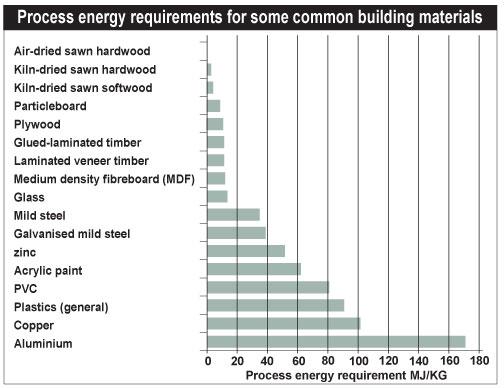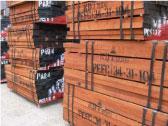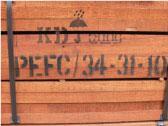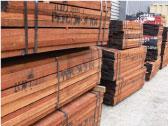05a. ENVIRONMENTAL ISSUES
Table of contents
- IS TIMBER MORE ENVIRONMENTALLY DESTRUCTIVE THAN ALUMINIUM?
- HOW DOES TIMBER COMPARE IN ENERGY EFFICIENCY, INSULATION & DURABILITY?
- HOW DOES TIMBER COMPARE IN ENERGY EFFICIENCY, INSULATION & DURABILITY?
- CAN ANY TIMBER BE USED FOR JOINERY?
- CAN PLANTATION PINE BE USED?
- WHERE DOES WOODWORKERS GET ITS TIMBER?
- DOES WOODWORKERS USE CERTIFIED TIMBER?
IS TIMBER MORE ENVIRONMENTALLY DESTRUCTIVE THAN ALUMINIUM?
It takes 5 times more energy to produce aluminium than wood. Aluminium production results in 8 times more air emissions and 300 times more water emissions than timber. Wood is one of the few natural building materials and is therefore not toxic, does not leach chemicals and is completely safe to handle and touch. As it ages it does so without breaking into environmentally damaging materials and is, in fact, naturally bio-degradable as landfill. In joinery situations there are ample examples of timber joinery continuing to function after 500 years with regular but minimal maintenance. Wood is the largest readily renewable natural resource and its reserves are INCREASING worldwide every year.
DOES HARVESTING TREES INCREASE THE GREENHOUSE EFFECT?
Timber contributes significantly less to the Greenhouse Effect than other building materials. Growing trees absorb CO2 (the Greenhouse gas), locking the carbon in the wood structure and releasing oxygen into the environment. As trees mature the rate of CO2 absorption declines and the intelligent harvesting of mature trees and replanting with young fast growing trees actually increases CO2 absorption. The carbon stored and released by various building materials during their formation is summarized in the table:
|
Material
|
Carbon Released (kg per cubic metre)
|
Carbon Stored(kg per cubic metre)
|
|
Timber
|
12
|
250
|
|
Steel
|
5320
|
0
|
|
Concrete
|
120
|
0
|
|
Aluminium
|
22000
|
0
|

HOW DOES TIMBER COMPARE IN ENERGY EFFICIENCY, INSULATION & DURABILITY?
Easy to fabricate into virtually any shape or size, timber is a natural insulator and intrinsically strong, compared to metal windows that are natural heat conductors. Timber joinery gives natural energy efficiency and provides a long life. Wood doesn't rust or corrode and can therefore easily be rejuvenated whereas aluminium's powdercoat has a defined lifespan of between 10 and 20 years depending on site conditions. Joinery timbers such as cedar or rosewood are chosen because of their natural termite and rot resistance. Timber has the natural ability to reduce noise penetration and increase thermal efficiency. Advancements in coating technologies eliminate the need for high maintenance re-coating which was previously timber's Achilles heel. Recommended coating systems provide long life and simple maintenance and are the subject of a separate Woodworkers FAQs sheet. This development, coinciding with the current designer preference for stronger looking window sections have seen timber maintain a healthy 25% of national market share, with increasing market growth in Queensland and NSW. Timbers most visible and easily appreciated asset lies in its natural beauty and warmth. A house without timber is a home without soul and timber transcends fashion trends by never being out of style.
CAN ANY TIMBER BE USED FOR JOINERY?
NO. The ideal joinery timber grows straight out of the ground towards a light in the forest canopy so that its grain is straight and has minimal locked in stresses that can cause the timber to twist or bow. Trees grown in broken forest have wind pressures on them constantly, which stretch and compress the timber as they sway, making them unsuitable for precision joinery work. Traditionally, most Queensland joinery timbers have come from the tropical and sub-tropical regions in the state's north where straight growing conditions exist. Since settlement, Cedar was logged as first preference without being replanted, resulting in it becoming scarce by the end of World War 1. The preference then moved to virgin hoop and northern silky oak, supplies of which dwindled into the early 1980s when Australia locked most northern forests into the National Estate. Of the 960,000 million hectares of tropical rainforest estimated to have existed at the time of European settlement, 75% still exist. For the past 20 years most joinery timbers have been imported as a result of the poor forestry practices of earlier generations, where replanting and reforestation did not occur. These earlier sins have been belatedly but effectively addressed in the past 20 years, with Australia now being self-sufficient overall in timber having increased its plantations by almost 80,000 hectares per year, 42% of which are hardwood species. While these increasing timber stocks will suffice for most building purposes however, they are still too juvenile and unstable for use in precision timberwork like joinery.
CAN PLANTATION PINE BE USED?
Not successfully. It has been Woodworker's experience that plantation pine is very prone to warp & twist and needs to be chemically impregnated to give it any durability. We have serious health and safety concerns about using chemically impregnated timber as the past has shown that it can take a generation for its true effects to become known. Finger jointing pine can eliminate its internal stresses but does not produce an aesthetically acceptable product and we doubt its durability for external joinery.
WHERE DOES WOODWORKERS GET ITS TIMBER?
Woodworkers involves itself in the entire supply chain of its logs, buying them at source to ensure they originate from legal concessions where sustainable yield practices are enforced. We then have all sawmilling & drying done by our indigenous suppliers. Woodworkers seek to ensure that 100% of every log gets used and has instigated a recycling program to ensure this occurs. Consequently, while the best cuts of the log may be dressed and exported for Australian manufacture, the secondary off cuts are gathered for window and door component manufacture in the country of origin. Woodworkers has permanent expatriate supervision employed to ensure quality standards are met and that all material is used, even down to the very smallest chip being used as fuel to kiln dry the larger cuts. This integrated process is in accord with World Bank guidelines for value adding to the benefit of local communities. While we sometimes need to top up timber supplies from other Australian importers, we use only responsible companies that avoid illegal logging sources. Less than 250 full logs are used in the yearly production of Woodworkers joinery, creating employment for over 100 people in Australia and a similar number off shore. By sourcing from legal, sustainable managed concessions we believe the timber we use is being continuously re-grown in balance with our needs.
DOES WOODWORKERS USE CERTIFIED TIMBER?
The Australian Forest Certification Scheme (AFCS) is the official timber certification scheme in Australia which is part of the Geneva Based PEFC (Programme for Endorsement of Forest Certification schemes). PEFC is the largest forest certification system globally encompassing 230 million hectares of forest in 34 countries. PEFC aims to administer UN standards for Forest management to ensure sustainable timber harvesting in cooperation with national governments, business and landowners. PEFC certified timber indicates that the timber has been harvested legally and sustainably and has been tracked from its place of origin to the market place to ensure it is not mixed with non-certified timber. Certification is largely an administrative system with a number of logistical hurdles which add to the cost of the product. Because of this many suppliers do not seek to have their product certified even though it comes from the same supply chain as the certified timber. Woodworkers seeks to increase the volumes of PEFC timber available (which are currently very limited) as well as Greenpeace certified tropical hardwoods which also appear irregularly in restricted quantities. At present it is not an achievable option to provide all joinery product from PEFC or other certified timber sources except for small projects. Consequently Woodworkers integrates certified timber in its daily production but cannot generally offer completely certified product until all of our supply chains become more green orientated. This remains a work in progress and a goal for the company which is likely to become a reality over the coming decade.    |
 My Account
My Account My Wishlist
My Wishlist My Enquiries
My Enquiries
